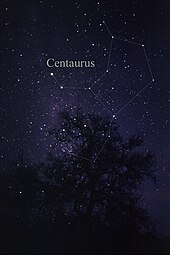Alpha Centauri

Alpha Centauri (Latinized from α Centauri, abbreviated Alpha Cen or α Cen) is the closest star system and closest planetary system to Earth's Solar System at 4.37 light-years (1.34 parsecs) from the Sun. It is a triple star system, consisting of three stars: α Centauri A (officially Rigil Kentaurus), α Centauri B (officially Toliman), and α Centauri C (officially Proxima Centauri).
Alpha Centauri A and B are Sun-like stars (Class G and K), and together they form the binary star Alpha Centauri AB. To the naked eye, the two main components appear to be a single star with an apparent magnitude of −0.27, the brightest star in the southern constellation of Centaurus and the third-brightest in the night sky, outshone only by Sirius and Canopus.
Alpha Centauri A has 1.1 times the mass and 1.519 times the luminosity of the Sun, while Alpha Centauri B is smaller and cooler, at 0.907 times the Sun's mass and 0.445 times its luminosity. The pair orbit around a common centre with an orbital period of 79.91 years. Their elliptical orbit is eccentric, so that the distance between A and B varies from 35.6 AU (astronomical units), or about the distance between Pluto and the Sun, to 11.2 AU, or about the distance between Saturn and the Sun.
Alpha Centauri C, or Proxima Centauri, is a small and faint red dwarf (Class M). Though not visible to the naked eye, Proxima Centauri is the closest star to the Sun at a distance of 4.24 light-years (1.30 pc), slightly closer than Alpha Centauri AB. Currently, the distance between Proxima Centauri and Alpha Centauri AB is about 13,000 astronomical units (0.21 ly), equivalent to about 430 times the radius of Neptune's orbit.
Proxima Centauri has two planets: Proxima b, an Earth-sized exoplanet in the habitable zone discovered in 2016; and Proxima c, a ringed super-Earth 1.5 AU away, discovered in 2019. Alpha Centauri B has one retracted planet (Alpha Centauri Bb), and one potential candidate (Bc).
Comments
Post a Comment